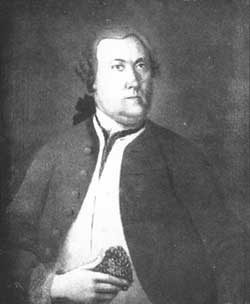<Back to Index>
- Natural Scientist Pehr Kalm, 1716
- Bluesman Furry Lewis, 1893
- Lehendakari of Euzkadi José Antonio Aguirre y Lecube, 1904
PAGE SPONSOR

Pehr Kalm (March 6, 1716 – November 16, 1779) (in Finland also known as Pietari Kalm and in some English language translations as Peter Kalm) was a Swedish-Finnish explorer, botanist, naturalist, and agricultural economist. He was one of Carl Linnaeus's most important apostles. Among his many accomplishments, Kalm can be credited for the first description of Niagara Falls written by someone trained as a scientist.
Kalm was born in Ångermanland, where his parents had taken refuge from Finland during the Great Northern War. His father died six weeks after his birth. When the hostilities were over, his widowed mother returned with him to Närpes in Ostrobothnia, where Kalm's father had been a Lutheran minister. Kalm studied at the Academy of Turku from 1735, and from 1740 at the University of Uppsala, where he became one of the first students of the renowned naturalist Carolus Linnaeus. In Uppsala Kalm became the superintendent of an experimental plantation owned by his patron, Baron Sten Karl Bielke.
Kalm did field research in Sweden, Russia, and Ukraine from 1742 to 1746, when he was appointed Docent of Natural History and Economics at the Academy of Turku. In 1747 the Academy elevated him to Professor of Economics, and the same year he was also appointed by Linneaus and the Royal Swedish Academy of Sciences (which he had been a member of since 1745) to travel to North America to find seeds and plants that might prove useful for agriculture or industry. In particular, they wanted him to bring back the red mulberry in the hope of starting a silk industry in Finland (which was then an integral part of Sweden, today also known as Sweden-Finland).
On his journey from Sweden to Philadelphia, Kalm spent six months in England, where he met many of the important botanists of the day. Kalm arrived in Pennsylvania in 1748; there he was befriended by Benjamin Franklin and John Bartram. Kalm made the Swedish-Finnish community of Raccoon (now Swedesboro) in southern New Jersey his
base of operations. There he served as the substitute pastor of the
local church, and there he married the widow of the former pastor in
1750. He made trips as far west as Niagara Falls and as far north as Montreal and Quebec before
returning in 1751. After his return to Finland to take his post as
Professor at the Turku Academy, he established botanical gardens in Turku, and taught there until his death in 1771. Kalm's journal of his travels was published as En Resa til Norra America (Stockholm, 1753 – 1761). It was translated into German, Dutch, and French, and into English in 1770 as Travels into North America. Another
American edition was translated by Adolph B. Benson and published in
1937; it is an important standard reference regarding life in colonial
North America. Kalm described not only the flora and fauna of the New
World, but the lives of the Native Americans and the British and French colonists whom he met. In his Species Plantarum, Linnaeus cites Kalm for 90 species, 60 of them new, including the genus Kalmia, which Linnaeus named after Kalm. Kalmia latifolia (Mountain-laurel) is the state flower of Pennsylvania and Connecticut. Kalm's ethnicity and mother tongue became a topic almost a century after his death, during Finland's so-called language strife. Kalm himself usually signed letters as "Pehr Kalm", and he was born and raised in the bi-cultural and bi-lingual Finland-Swedish Närpes, and all his known professional writings were done in Latin and Swedish. Another famous Swedish scientist from territories that later became Finland, Anders Chydenius, was a student of Pehr Kalm's.